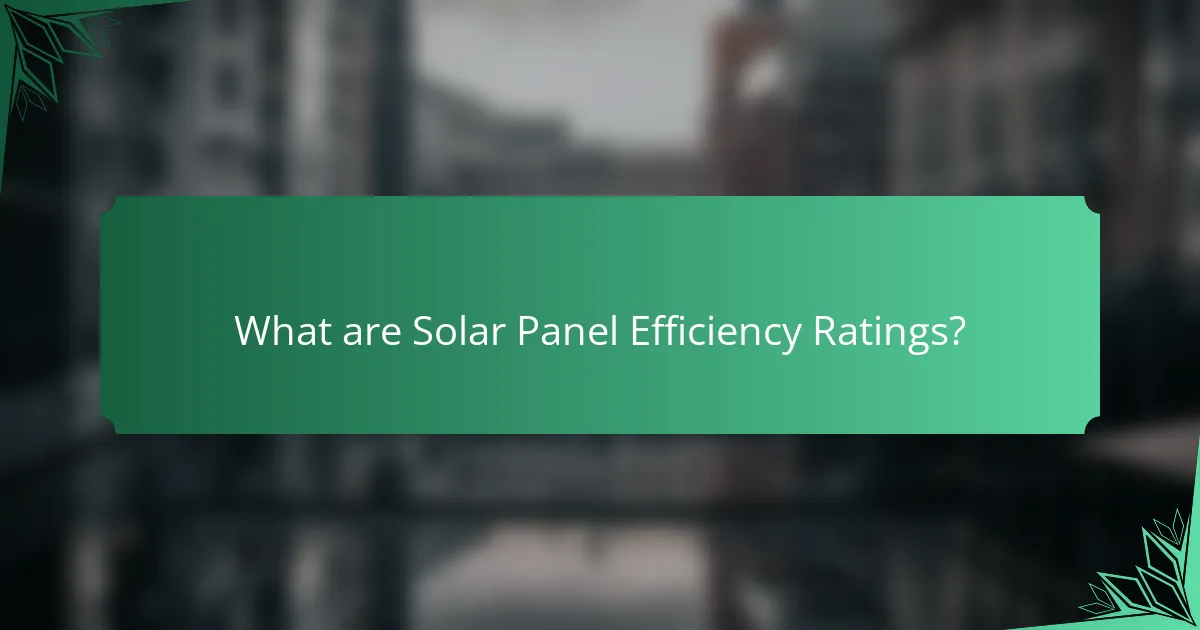
What are Solar Panel Efficiency Ratings?
Solar panel efficiency ratings measure how effectively a solar panel converts sunlight into usable electricity. These ratings are expressed as a percentage. Higher efficiency ratings indicate that a panel can produce more electricity from the same amount of sunlight. Most solar panels have efficiency ratings ranging from 15% to 22%. The efficiency can be influenced by factors such as the type of solar cell technology used. For example, monocrystalline panels typically offer higher efficiency than polycrystalline panels. Efficiency ratings are crucial for consumers to determine the best solar solution for their needs. The National Renewable Energy Laboratory (NREL) provides standardized testing for these ratings, ensuring reliability and accuracy.
How are Solar Panel Efficiency Ratings determined?
Solar panel efficiency ratings are determined by measuring the amount of sunlight converted into usable electricity. This process involves standardized testing under controlled conditions. The most common standard is the IEC 61215, which evaluates performance metrics. Efficiency is expressed as a percentage of the total solar energy received. For example, a panel with 20% efficiency converts 20% of sunlight into electricity. Testing includes factors such as temperature, light intensity, and spectral conditions. Manufacturers provide these ratings based on laboratory results. Independent organizations often verify these ratings to ensure accuracy.
What metrics are used to measure efficiency in solar panels?
The metrics used to measure efficiency in solar panels include conversion efficiency, fill factor, and performance ratio. Conversion efficiency indicates the percentage of sunlight converted into usable electricity. This metric is crucial for determining the overall effectiveness of a solar panel. Fill factor measures the quality of the solar cell and is calculated by the ratio of the maximum power point to the product of open-circuit voltage and short-circuit current. A higher fill factor signifies better performance. Performance ratio evaluates the actual output of a solar panel compared to its potential output under standard test conditions. This metric accounts for losses due to factors like temperature and shading. These metrics collectively provide a comprehensive assessment of solar panel efficiency.
How do environmental factors influence efficiency ratings?
Environmental factors significantly influence solar panel efficiency ratings. Temperature affects the electrical performance of solar panels. Higher temperatures typically reduce efficiency due to increased resistance in the materials. For example, studies show that for every degree Celsius increase, efficiency can drop by approximately 0.5%.
Solar irradiance is another crucial factor. Higher levels of sunlight increase energy production, directly improving efficiency ratings. According to the National Renewable Energy Laboratory, optimal conditions can boost output significantly.
Additionally, shading from trees or buildings can drastically reduce performance. Even partial shading can lead to a substantial drop in energy generation. Dust and debris accumulation on panels also hinders light absorption, further decreasing efficiency.
The angle and orientation of the panels relative to the sun’s path are vital for maximizing exposure. Proper installation can enhance energy capture and improve overall efficiency ratings.
Why are Solar Panel Efficiency Ratings important?
Solar panel efficiency ratings are important because they indicate how effectively a solar panel converts sunlight into electricity. Higher efficiency ratings mean more energy production from the same amount of sunlight. This is crucial for maximizing energy output, especially in limited space. For example, a panel with a 20% efficiency rating generates more electricity than one with a 15% rating under identical conditions. Efficiency ratings also impact the overall cost-effectiveness of solar installations. Higher efficiency can lead to lower installation costs per watt generated. According to the National Renewable Energy Laboratory, advancements in solar technology have led to efficiency improvements, making modern panels significantly more effective than older models.
How do efficiency ratings affect energy production?
Efficiency ratings directly influence energy production by indicating how effectively a solar panel converts sunlight into electricity. Higher efficiency ratings mean more electricity generated from the same amount of sunlight. For example, a solar panel with a 20% efficiency rating converts 20% of incoming solar energy into usable electricity. This results in greater energy output compared to a panel with a 15% efficiency rating, which only converts 15% of the sunlight.
As technology advances, efficiency ratings are expected to improve, leading to increased energy production. Innovations such as bifacial panels and improved materials contribute to these advancements. According to the National Renewable Energy Laboratory, advancements in solar cell technology have the potential to increase efficiency ratings beyond 25%. This would significantly enhance energy production capabilities, making solar energy a more viable option for widespread use.
What role do efficiency ratings play in consumer choice?
Efficiency ratings are crucial in consumer choice for solar panels. They directly influence the perceived value and performance of the product. Higher efficiency ratings indicate more energy production from the same amount of sunlight. This translates to lower installation costs per watt of electricity generated. Consumers often compare efficiency ratings to determine which panels will yield better long-term savings. Research from the National Renewable Energy Laboratory shows that higher efficiency panels can produce up to 20% more energy over their lifespan. Thus, efficiency ratings significantly impact purchasing decisions and investment returns in solar technology.

What Innovations are Shaping Solar Panel Technology?
Innovations shaping solar panel technology include bifacial solar panels, perovskite solar cells, and advanced tracking systems. Bifacial solar panels capture sunlight from both sides, increasing energy output by up to 27%. Perovskite solar cells offer higher efficiency rates and lower production costs compared to traditional silicon cells. Advanced tracking systems optimize the angle of solar panels, improving energy capture by 20-50%. These innovations collectively enhance the efficiency and affordability of solar energy solutions.
How are advancements in materials improving solar panel efficiency?
Advancements in materials are significantly improving solar panel efficiency. New materials like perovskite have shown higher absorption rates than traditional silicon. Perovskite solar cells can achieve efficiencies over 25%, compared to silicon’s typical 20%. Additionally, bifacial solar panels, which utilize both sides for energy capture, enhance overall efficiency. Researchers are also developing transparent solar cells that can be integrated into windows. These innovations enable better light absorption and conversion into electricity. The National Renewable Energy Laboratory reports that these advancements can lead to a 50% increase in energy output. Therefore, material advancements are crucial for enhancing solar panel efficiency.
What new materials are being used in solar panel production?
Perovskite materials are increasingly being used in solar panel production. These materials offer high efficiency and lower production costs compared to traditional silicon-based panels. Perovskite solar cells can achieve efficiencies exceeding 25% in laboratory settings. Additionally, materials like organic photovoltaics and tandem cells are being explored. Organic materials provide flexibility and lightweight options for solar applications. Tandem cells combine different materials to capture a broader spectrum of sunlight. These innovations are driving advancements in solar technology. Research indicates that these materials could revolutionize the solar industry by improving efficiency and reducing costs.
How do these materials enhance performance and durability?
Advanced materials enhance solar panel performance and durability by improving energy conversion efficiency and resistance to environmental stressors. For example, perovskite materials can achieve efficiencies exceeding 25% in energy conversion. These materials also exhibit flexibility, allowing for lightweight and versatile solar panel designs. Additionally, protective coatings made from durable polymers increase resistance to UV degradation and moisture intrusion. Research indicates that panels using these materials can last up to 30 years with minimal efficiency loss. Furthermore, innovations like bifacial solar panels utilize materials that capture sunlight from both sides, enhancing overall energy yield. Thus, the integration of advanced materials significantly boosts both the performance and longevity of solar panels.
What technological innovations are increasing solar panel efficiency?
Technological innovations increasing solar panel efficiency include bifacial solar panels, which capture sunlight on both sides. These panels can increase energy generation by up to 30%. Another innovation is the use of perovskite materials, which have shown efficiency rates exceeding 25% in laboratory settings. Tracking systems that adjust the angle of solar panels to follow the sun can enhance energy capture by 25% or more. Additionally, advancements in anti-reflective coatings reduce light loss, improving overall performance. Research indicates that integrating these technologies can lead to significant efficiency gains in solar energy systems.
How do smart technologies integrate with solar panels?
Smart technologies integrate with solar panels through advanced monitoring and control systems. These systems optimize energy production by analyzing performance data in real-time. Smart inverters convert solar energy into usable electricity while managing grid interactions. Energy management systems coordinate energy usage and storage, enhancing efficiency. IoT devices enable remote monitoring and diagnostics, allowing for proactive maintenance. This integration can increase solar panel efficiency by up to 30%, as reported by the National Renewable Energy Laboratory. Additionally, smart technologies facilitate grid stability and support renewable energy adoption.
What role does artificial intelligence play in optimizing solar energy systems?
Artificial intelligence plays a crucial role in optimizing solar energy systems. It enhances energy production by predicting solar irradiance and weather patterns. AI algorithms analyze historical data to improve energy forecasting accuracy. This leads to better energy management and increased efficiency. Additionally, AI can optimize the placement and orientation of solar panels. Machine learning models identify the best configurations for maximum sunlight exposure. AI also facilitates real-time monitoring and maintenance of solar systems. Predictive maintenance reduces downtime and operational costs. Studies indicate that AI can increase solar energy output by up to 20%.

What are the Future Trends in Solar Panel Efficiency?
Future trends in solar panel efficiency include advancements in materials and technology. Perovskite solar cells are gaining attention for their potential to surpass traditional silicon cells. These cells can achieve efficiencies above 25% in laboratory settings. Bifacial solar panels are also becoming popular. They capture sunlight from both sides, increasing overall energy output.
Moreover, integrating artificial intelligence into solar energy systems optimizes performance and maintenance. AI can predict energy production and detect faults in real-time. Another trend is the development of transparent solar panels. These can be used in windows, expanding applications without sacrificing aesthetics.
Additionally, research is focusing on enhancing recycling processes for solar panels. This will improve sustainability and reduce waste. Overall, these trends indicate a shift towards more efficient, versatile, and sustainable solar energy solutions.
How is the market for solar panels expected to evolve?
The market for solar panels is expected to grow significantly in the coming years. According to a report by Fortune Business Insights, the global solar panel market was valued at approximately $52 billion in 2020. It is projected to reach around $223 billion by 2028, growing at a compound annual growth rate (CAGR) of about 19.9%. This growth is driven by increasing demand for renewable energy sources. Governments worldwide are implementing policies to promote solar energy adoption. Additionally, advancements in solar panel technology are enhancing efficiency and reducing costs. The rise of energy storage solutions is also contributing to market evolution. Overall, the solar panel market is set for robust expansion due to these factors.
What factors will drive changes in solar panel efficiency ratings?
Advancements in materials and technology will drive changes in solar panel efficiency ratings. Innovations such as perovskite solar cells show potential for higher efficiency. Improved manufacturing processes can enhance the quality of solar panels. Research indicates that bifacial panels can capture more sunlight, increasing efficiency. Environmental conditions, such as temperature and shading, also impact performance ratings. Government policies and incentives can encourage the adoption of more efficient technologies. Market demand for renewable energy solutions will push manufacturers to improve efficiency ratings. Ongoing research and development efforts will continue to influence these changes.
How will consumer preferences shape the future of solar technology?
Consumer preferences will significantly shape the future of solar technology. Increased demand for sustainable energy sources drives innovation in solar products. Consumers are prioritizing efficiency and cost-effectiveness in their purchasing decisions. According to a 2021 survey by the Solar Energy Industries Association, 88% of consumers support solar energy. This preference influences manufacturers to develop higher efficiency panels and more affordable systems. As consumers seek integrated smart technology, solar companies are investing in smart grid solutions. Moreover, preferences for aesthetic designs are leading to innovations in solar panel appearance. This trend results in more attractive solar installations that blend with home architecture. Thus, consumer preferences are a key driver of advancements in solar technology.
What challenges and opportunities lie ahead for solar panel efficiency?
The challenges ahead for solar panel efficiency include material limitations and manufacturing costs. Current silicon-based solar cells face efficiency ceilings around 26%. Innovations in perovskite materials show promise for higher efficiency but raise stability concerns. Additionally, the recycling of solar panels presents environmental challenges.
Opportunities for improvement lie in advanced technologies like bifacial panels and solar tracking systems. Bifacial panels can capture sunlight from both sides, potentially increasing energy output. Solar tracking systems adjust panel angles to follow the sun, enhancing efficiency by up to 25%.
Investment in research and development can lead to breakthroughs in materials and production techniques. Governments and private sectors are increasingly funding solar technology advancements. The global push for renewable energy creates a favorable market for innovative solar solutions.
How can the industry address the challenges of efficiency improvements?
The industry can address the challenges of efficiency improvements by investing in advanced technologies. Innovations such as bifacial solar panels can capture sunlight from both sides, increasing energy output. Additionally, integrating artificial intelligence can optimize energy production based on weather patterns. Research indicates that using perovskite materials can enhance efficiency rates significantly, potentially exceeding 30%. Furthermore, enhancing manufacturing processes can reduce costs and improve the scalability of high-efficiency panels. Collaborations between industry stakeholders can drive research and development efforts, leading to breakthroughs. Adopting standardized efficiency ratings will also help consumers make informed decisions. These strategies collectively strengthen the industry’s capacity to improve solar panel efficiency.
What opportunities exist for innovation in solar energy systems?
Opportunities for innovation in solar energy systems include advancements in photovoltaic materials, energy storage solutions, and smart grid integration. Researchers are exploring perovskite solar cells, which promise higher efficiency and lower production costs. Energy storage innovations, such as solid-state batteries, enhance the reliability of solar energy by storing excess power. Smart grid technologies enable better energy management and integration of renewable sources. According to the International Energy Agency, solar power capacity could reach 4,000 GW by 2030, indicating significant growth potential. These innovations can help reduce costs and increase adoption rates of solar energy systems.
What practical tips can consumers follow to maximize solar panel efficiency?
Consumers can maximize solar panel efficiency by ensuring optimal placement and maintenance. Position solar panels at an angle that captures maximum sunlight, ideally between 30 to 45 degrees. Regularly clean the panels to remove dirt and debris, which can block sunlight. Monitor the shading from nearby trees or buildings, as even partial shade can significantly reduce output. Use high-efficiency solar panels, which convert more sunlight into electricity. Invest in a solar inverter that matches the panel’s capacity to optimize energy conversion. Additionally, consider installing a solar tracking system that adjusts the panel’s position throughout the day. Data shows that proper maintenance and positioning can increase solar energy production by up to 25%.
Solar panel efficiency ratings are critical metrics that indicate how effectively solar panels convert sunlight into usable electricity, with typical ratings ranging from 15% to 22%. This article explores the determination of these ratings, the metrics used to evaluate efficiency, and the impact of environmental factors on performance. Additionally, it highlights recent innovations in solar technology, such as bifacial panels and perovskite materials, which enhance efficiency and energy output. Future trends in solar panel technology, including advancements in materials and smart technologies, are also discussed, along with the evolving market dynamics and consumer preferences shaping the industry.